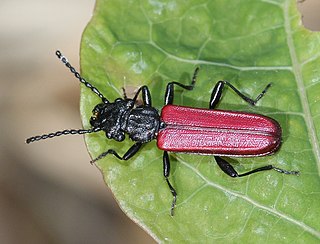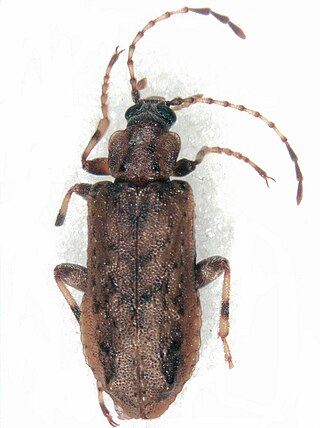| Promanus | |
|---|---|
 | |
| Scientific classification | |
| Kingdom: | |
| Phylum: | |
| Class: | |
| Order: | |
| Family: | |
| Genus: | Promanus Sharp, 1877 [1] |
| Species | |
Promanus is a genus of beetles of the family Lophocateridae, [2] endemic to New Zealand. [3]
| Promanus | |
|---|---|
 | |
| Scientific classification | |
| Kingdom: | |
| Phylum: | |
| Class: | |
| Order: | |
| Family: | |
| Genus: | Promanus Sharp, 1877 [1] |
| Species | |
Promanus is a genus of beetles of the family Lophocateridae, [2] endemic to New Zealand. [3]

The longhorn beetles (Cerambycidae), also known as long-horned or longicorns, are a large family of beetles, with over 35,000 species described.

The Cucujidae, or flat bark beetles, are a family of distinctively flat beetles found worldwide under the bark of dead trees. The family has received considerable taxonomic attention in recent years and now consists of 70 species distributed in five genera. It was indicated Cucujus species are scavengers, only feeding on pupae and larvae of other insects and on other subcortical beetles such as their own. Since the Cucujidae prey on larvae of potentially tree damaging beetles that spread fungal diseases, they are considered to be beneficial to the health of living trees.

The family Archeocrypticidae is a small group of beetles with no vernacular common name, though recent authors have coined the name cryptic fungus beetles. Adults and larvae seems to be saprophagous and are often found in plant litter. Worldwide, about 10 genera and 50 species are found, most species are pantropical. Enneboeus caseyi has been recorded from the American South, Central America, and Mexico. About 20 species are found in Australia, in the genera Enneboeus,Australenneboeus and Gondwanenneboeus,Archeocrypticus,Falsoplatydema, Nothenneboeus, Sivacrypticus and Wattianus. They are largely absent from the Palearctic and Nearctic regions.

Prostomidae is a family of beetles with no vernacular common name, though recent authors have coined the name jugular-horned beetles. They are often found in dead wood. The family consist of two extant genera with about 20 species. Prostomis americanus is known from North America. Other species of Prostomis are found in Europe, Africa, the Pacific region and East Asia. Species of Dryocora are known from New Zealand, Australia and Tasmania.

Corylophidae is a family of minute hooded beetles, sometimes called minute fungus beetles, in the superfamily Coccinelloidea. There are about 18 genera and at least 120 described species in Corylophidae. They feed on microfungi such as molds, and are often found associated with bark, as well as in leaf litter and other decaying vegetation. In older literature, the family name was often given as Orthoperidae.

Hadramphus tuberculatus is a rare weevil endemic to Canterbury in the South Island of New Zealand. It was thought to be extinct in 1922 but was rediscovered in 2004.

Agyrtidae, or primitive carrion beetles, are a small family of beetles belonging to Staphylinoidea. They are found in mostly temperate areas of the Northern Hemisphere and in New Zealand.

Jacobsoniidae are a family of tiny beetles belonging to Staphylinoidea. The larvae and adults live under bark, in plant litter, fungi, bat guano and rotten wood. There are around 28 described species in three genera:

Chaetosomatidae is a small family of beetles, in the superfamily Cleroidea. There are three extant genera, two of which are endemic to New Zealand with the other (Malgassochaetus) native to Madagascar. Members of this family are predaceous on wood-boring insects.

Cavognathidae is a family of beetles, in the superfamily Cucujoidea. It contains a single genus, Taphropiestes with around a dozen species known from South America, Australia and New Zealand. In Australian and New Zealand species adults and larvae have been found living in bird nests, but their ecology is unclear, but they are possibly scavengers.

The Chalcodryidae are a family of beetles in the superfamily Tenebrionoidea. It contains at least five species in two genera Chalcodrya and Philpottia, which are endemic to New Zealand. They are generally found associated with moss or lichen covered branches, with the larvae having been found to be associated with dead twigs. They are likely noctural, feeding on lichen and other plant material at night. The genera Sirrhas and Onysius, formerly placed in this family, have subsequently been transferred to Promecheilidae.

Thomas Broun was a Scottish-born soldier, farmer, teacher and entomologist, who spent much of his career in New Zealand. He is known for his study of the beetles (Coleoptera) of New Zealand.

Chelonariidae or turtle beetles is a family of beetles in the superfamily Byrrhoidea. It was described by Blanchard in 1845. There are 3 genera with around 300 described species. Little is known of their ecology, though it seems they are associated with the roots of orchids and the nests of ants and termites. Their exoskeletons are heavily sclerotised and their limbs can be effectively retracted into their bodies due to the presence of socket-like cavities. Adult specimens have seed-shaped bodies that are typically colored brown or black with lighter patches.

Clambidae is a family of beetles. They are known commonly as the minute beetles or the fringe-winged beetles. They are found worldwide on every continent except Antarctica.

Promanus depressus is a species of beetles of the family Lophocateridae, endemic to New Zealand.

Throscidae is a family of elateroid beetles found worldwide with around 150 species in 5 extant genera. The larvae are soil-dwelling, siphoning fluid from mycorrhizae attached to trees. The adults are short-lived, with the adult males being noted for a complex mating dance. Like some other elateroids, they are capable of clicking.

Cyclaxyridae are a family of beetles in the superfamily Cucujoidea. The only living genus is Cyclaxyra, with two species endemic to New Zealand. Other species have been named from fossils. They are also known as sooty mould beetles due to the association of Cyclaxyra with sooty mould. The extant species are mycophagous, feeding on spores, conidia, and hyphae.

Metaxina is the only genus in the beetle family Metaxinidae. Its only species is Metaxina ornata. It endemic to the South island of New Zealand, where it is associated with sooty mold growing on Nothofagus trees. Both the larvae and adults are likely predaceous, feeding on insects and other arthropods. It is considered to be a member of the superfamily Cleroidea. Genetic studies have suggested that Metaxina should be considered a member of Chaetosomatidae, rather than constituting its own family.

Promecheilidae is a family of beetles in the superfamily Tenebrionoidea. Perimylopidae is considered a synonym. They are found in southern South America and associated archipelagos like South Georgia and the Falklands, New Zealand and Tasmania. Some species are associated tree ferns and moss-covered dead wood, and other forested habitats, while others are associated with peat bogs, grasslands and coastal habitats. They are probably phytophagus, feeding on lichen, moss, and other plant material.

Lophocateridae is a family of beetles in the superfamily Cleroidea, formerly included in the Trogossitidae. Members of the group have a variety of ecologies, including as predators of other insects, as fungivores, or are phytophagous.